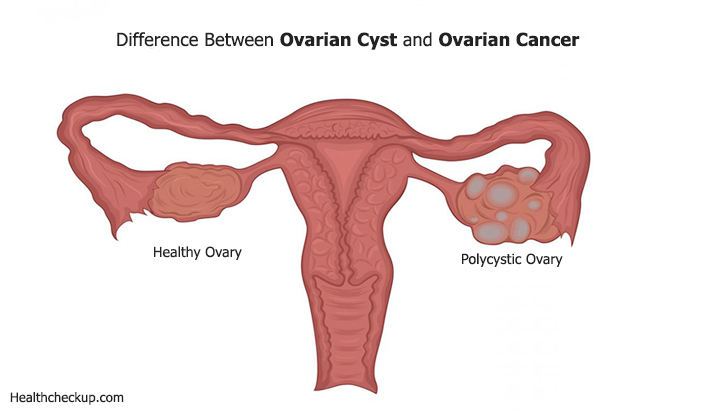Many women, when they first hear the term ovarian cyst, they instantly connect it to the presence of ovarian cancer. But are ovarian cancer and ovarian cysts really the same? And what causes ovarian cancer misdiagnosed as cyst or the other way around? Is there a difference between an ovarian cyst and ovarian cancer, and if there is, what would it be? In today’s article, we explore the answers to these questions and share some vital information that every woman should know.
The Difference Between Ovarian Cancer And Ovarian Cyst
Ovarian cancer is misdiagnosed as ovarian cyst by many of the women and the follwoing is the main difference between ovarian cancer and oavrian cysts. Ovarian cysts are described as fluid-filled sacs that can develop in one or both ovaries. They can affect women of any age; however, previous research has shown that ovarian cysts are most common within women of childbearing age since ovarian cysts are linked to the process of ovulation. The ovarian cysts that develop during the menstrual cycle are called functional cysts, and they are suggested to be most common. Ovarian cancer is misdiagnosed as cyst and Ovarian cysts are often mistaken for ovarian cancer. Ovarian cysts are either benign or malignant. Malignant ovarian cysts are only seen in rare cases, with the benign being the most common of them all. In most cases of benign ovarian cysts, no treatment is needed as they are considered to be harmless and usually resolve on their own. However, sometimes, they can also cause a rupture, bleeding, and pain to take place.
Ovarian cancer occurs when the cells in the ovaries multiply in an uncontrolled way so that a cancerous mass is formed, called ovarian cancer. There are different types of ovarian cancer that can develop depending on where exactly in the ovaries has cancer began. Of all types, it is the epithelial ovarian cancer that accounts for about 85% of 90% of the cases of ovarian cancer, being the most common type of all.
The Symptoms Of Ovarian Cancer And Ovarian Cyst
The reason why ovarian cancer is misdiagnosed as cyst or viceversa is the fact that these two conditions have similar symptoms. In both cases, most women fail to notice any signs at the beginning. It is possible to have either ovarian cancer or ovarian cyst and not realize it. Both health issues can cause mild to more severe symptoms, as the condition progresses. When they finally do cause symptoms, it is not uncommon that ovarian cancer is misdiagnosed as cyst because of the similarity in their symptoms as well. When a cyst is big enough that either blocks the blood supply or ruptures, it usually causes the symptoms that mimic those of late-stage ovarian cancer. Symptoms of both ovarian cancer and ovarian cysts include;
- Abdominal swelling and/or bloating;
- Abdominal pain;
- Abdominal pressure;
- Frequent urination;
- Irregularities in the menstrual cycle;
- Painful sexual intercourse;
- Nausea and vomiting;
- Feeling full after eating only a little;
- Constipation etc.
How Are Ovarian Cancer And Ovarian Cyst Diagnosed?
Ovarian cancer is misdiagnosed as cyst by many patients and if a patient has experienced any of the previously mentioned signs and symptoms, then it is always advised to consult the doctor right away. The usual diagnostic methods in cases where there is a suspicion of ovarian cysts, or ovarian cancer include the use of MRI and ultrasound. A physical exam and a blood sample will help the case as well. Patients are often tested for the presence of a specific tumor marker called CA-125, which present in high levels in the blood that may indicate a presence of ovarian cancer. To confirm or rule out ovarian cancer, a biopsy is often performed as well. A small sample of the suspected ovarian cancer or cyst is collected, which is later examined and analyzed.
Treatment Of Ovarian Cancer And Ovarian Cyst
As mentioned earlier, most ovarian cysts do not require any treatment since they either resolve on their own, or the patient continues to live without noticing them. In cases where the ovarian cysts are causing pain and any discomfort, the usual treatment plan includes surgical removal.
In the cases of ovarian cancer, one or more treatment methods may be applied. This would include using chemotherapy, surgery, and/or radiation to eliminate the present ovarian cancer. Ovarian cancer must be properly treated as soon as a proper diagnosis has been made. An early diagnosis doubles the chances of survival for these patients, which is why it is of vital importance that each woman visits their gynecologist on a regular level and report any symptoms that she might be experiencing lately.
Conclusion
Unfortunately, there have been many cases in which lives have been lost because of ovarian cancer has misdiagnosed as ovarian cyst. It is the similarity in their symptoms that makes it so easy for these two conditions to be mistaken and prevent the case of ovarian cancer from being discovered in time. The difference between an ovarian cyst and ovarian cancer is one that each doctor should be able to make.
Doctor, author and fitness enthusiast, Ahmed Zayed, MD, is a surgery resident with a passion for helping people live a happy healthy life. He is the author of numerous health-related books and contributor to several medicine, health and wellbeing websites.








